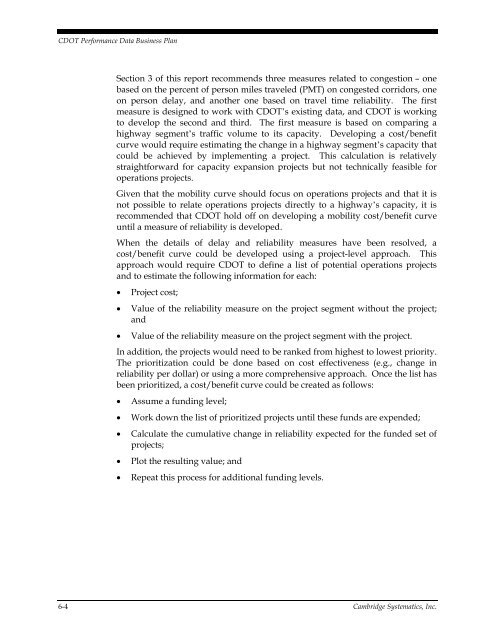CDOT Performance Data Business Plan - Cambridge Systematics
CDOT Performance Data Business Plan - Cambridge Systematics
CDOT Performance Data Business Plan - Cambridge Systematics
You also want an ePaper? Increase the reach of your titles
YUMPU automatically turns print PDFs into web optimized ePapers that Google loves.
<strong>CDOT</strong> <strong>Performance</strong> <strong>Data</strong> <strong>Business</strong> <strong>Plan</strong><br />
Section 3 of this report recommends three measures related to congestion – one<br />
based on the percent of person miles traveled (PMT) on congested corridors, one<br />
on person delay, and another one based on travel time reliability. The first<br />
measure is designed to work with <strong>CDOT</strong>’s existing data, and <strong>CDOT</strong> is working<br />
to develop the second and third. The first measure is based on comparing a<br />
highway segment’s traffic volume to its capacity. Developing a cost/benefit<br />
curve would require estimating the change in a highway segment’s capacity that<br />
could be achieved by implementing a project. This calculation is relatively<br />
straightforward for capacity expansion projects but not technically feasible for<br />
operations projects.<br />
Given that the mobility curve should focus on operations projects and that it is<br />
not possible to relate operations projects directly to a highway’s capacity, it is<br />
recommended that <strong>CDOT</strong> hold off on developing a mobility cost/benefit curve<br />
until a measure of reliability is developed.<br />
When the details of delay and reliability measures have been resolved, a<br />
cost/benefit curve could be developed using a project-level approach. This<br />
approach would require <strong>CDOT</strong> to define a list of potential operations projects<br />
and to estimate the following information for each:<br />
<br />
<br />
<br />
Project cost;<br />
Value of the reliability measure on the project segment without the project;<br />
and<br />
Value of the reliability measure on the project segment with the project.<br />
In addition, the projects would need to be ranked from highest to lowest priority.<br />
The prioritization could be done based on cost effectiveness (e.g., change in<br />
reliability per dollar) or using a more comprehensive approach. Once the list has<br />
been prioritized, a cost/benefit curve could be created as follows:<br />
<br />
<br />
<br />
<br />
<br />
Assume a funding level;<br />
Work down the list of prioritized projects until these funds are expended;<br />
Calculate the cumulative change in reliability expected for the funded set of<br />
projects;<br />
Plot the resulting value; and<br />
Repeat this process for additional funding levels.<br />
6-4 <strong>Cambridge</strong> <strong>Systematics</strong>, Inc.

















